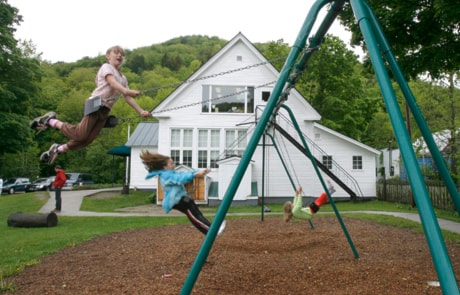Improving how Canadians design and build their roads, walkways and playgrounds could reduce the number of children injured or killed each year, suggests a new report, which also says that making it safer for kids to walk to school could lead to health benefits.
Injury is the leading cause of death among children in the developed world, and often involves a failure to negotiate a built environment, says Dr. Andrew Howard in a paper published Monday in the Canadian Medical Association Journal.
As an orthopedic surgeon at Toronto’s Hospital for Sick Children, he’s seen “the sort of severe and preventable tragedies that have to do with road traffic or sports and leisure injuries.”
Injury accounts for about 40 per cent of childhood deaths in industrialized countries. The report says 371,000 boys and 289,000 girls worldwide died of injuries in 2002 — including more than 180,000 killed in traffic accidents, mainly as pedestrians.
As he looked from country to country, Howard noted that new North American communities are still fairly “car-centric,” which is quite different from European cities and towns, where planning is around people who walk, public transit users and cyclists.
In Canada, he said, there are about 10 injury deaths per 100,000 children per year — altogether about 500 deaths.
“And if you look at Sweden, which has just as much snow and just as much northness and just as much distance between towns, a lot of rural dwellers, some cities, very similar, but (they have) about five deaths per 100,000 per year. Really half the rate.”
So what can be learned from Sweden?
One example he cited is suburban arterial roadways that force the cars underground to roundabouts at intersections, allowing pedestrians to walk along their route at ground level.
“You don’t build a bridge and make the sidewalk go up because people don’t like to climb across a road and will skip across the road, and then you have to put up a fence to stop them,” Howard explained in an interview.
“The cars go down to a traffic roundabout that is lower than grade, with ramps in, ramps out.”
Not only are pedestrians safe, but it does away with the side-impact car crash, which Howard said is responsible for 40 per cent of the deaths and bad neurological injuries for Canadian children.
“It’s an expensive intersection to build,” he observed.
“It’s a luxury intersection, right? And here the way that our incentives are written ... we almost direct our tax dollars toward luxury cars rather than towards luxury intersections.”
In Canada, he said, there could be changes in communities that would help transform unsafe circumstances into safe ones, including slower vehicle speeds, separation of pedestrians and cyclists from traffic, appropriate road-crossing controls and crossing guards near school zones.
Kathy Belton, associate director of the Alberta Centre for Injury Control & Research at the University of Alberta, agreed with Howard that we need to put children’s safety top of mind when looking at how to engineer an environment to separate traffic and pedestrians.
When it comes to the report’s observations that 50 per cent of children never walk to school and only 17 per cent do most of the time,
Belton noted that factors such as distance, fear of abduction and busy parents who want to get their child to school quickly also play a role.
“There’s more risk that that child will be hit by a car than taken by a stranger,” she said, adding that there are health benefits and feelings of confidence and being part of a community that come with walking, especially if kids do the trek together or in a “walking school bus” program.
On the subject of playgrounds, Howard said a study has found that you can prevent between 70 and 80 per cent of fractures by modifying the height of equipment and using the best impact-absorbing surfaces.
High-quality sand is best, he said, describing “the kind of sand that you or I or anybody else would dive for a volleyball in, probably a lot sooner than we would dive for a volleyball into a bed of wood chips or a rubber pad.”
“Why? Because you slide sideways when you land ... you dissipate the energy and you don’t create the bending forces that can break a bone.”
Howard’s report also dealt with drownings in home swimming pools.
He said four-sided fences are needed with gates that are self-closing and self-latching.
